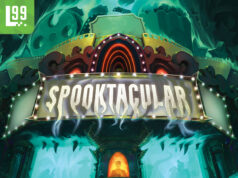Note: This preview uses pre-release components and rules. What you see here may be different from the final, published game.
 In 1993, a card game from a relatively unknown game designer dropped onto the scene in the form of Magic: The Gathering (MtG). Since that early alpha edition, Magic has proven to be a juggernaut in the gaming industry, with over 12 million active players today.
In 1993, a card game from a relatively unknown game designer dropped onto the scene in the form of Magic: The Gathering (MtG). Since that early alpha edition, Magic has proven to be a juggernaut in the gaming industry, with over 12 million active players today.
Since its launch, Magic has inspired numerous other card games, some good, others not so good. Which brings us to today’s preview of Allegiance: A Realm Divided. While playing Allegiance, you’d be hard pressed to not realize that the designer took some inspiration from MtG. And that’s not a bad thing; many games have drawn inspiration from this popular card game. The question remains, does Allegiance have enough to stand on its own two legs? Ready on to find out!
Allegiance: A Realm Divided is a strategy card game for 2-4 players that plays in about 45 minutes.
Game Overview:
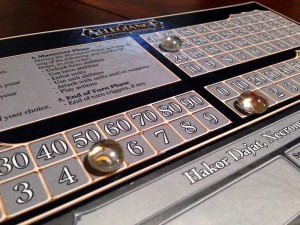
In Allegiance, each player will choose a unique hero to control as they muster their troops into battle. Each hero is highly thematic and also has unique powers that can be unlocked during the game. Each round, players will be collecting gold, using their hero powers, enlisting (summoning) troops to the battlefield and attacking their opponent. Players will increasingly gain more and more gold each turn, which they can then spend on more powerful units and abilities. Also, all the cards (except special hero ones) are shared between the players so there is no deck construction required. Players will use these cards and their hero’s powers to slowly whittle down their opponents health. Kill off your opponent and you’ll emerge the victor.
How to Play:
Each player starts the game by selecting of the game’s many different heroes to play. Each hero comes with their own playmat that has a life counter, special abilities, and powers that can be unlocked during the game. The heroes range from the defensive paladin (great for players that like to “turtle”), to the necromancer (raises units from the discard pile, very cool) to the Commander of the armies (good at spawning lots of troops). All told there were 9 heroes in our prototype copy and I wanted to try them all, that’s how unique they were.
Moving on, after each player has chosen a hero and taken a production board, each of the various boards is filled with counters to keep track of powers, life, gold and production. Then, the games three shared decks are shuffled. There are different decks for basic units, elite units and action cards. One of the nice things about having common decks are everyone will be on equal footing. Allegiance also avoids turning into the money sink that most CCGs fall victim to.
The game is played out in a series of turns that is broken up into 5 phases:
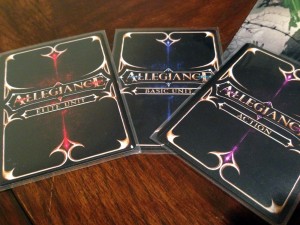
1. Production Phase: Increase your production by 1 (starts on 5) and the collect gold equal to your new production value.
2. Refresh Phase: Unexhaust (untap) any cards that were exhausted and move your entire cool down counters one space (more on that later).
3. Draw Phase: Draw 1 card from any of the 3 decks.
4. Maneuver Phase: This is where the meat of the game happens. Pretty much anything you do in Allegiance is considered a Maneuver. You can take as many maneuvers as you want, in any order. Some possible choices would be:
• Enlist a unit: You pay the cost in gold and bring the unit card to the battlefield. That unit must wait a turn before attacking.
• Unlock a power: Each player’s hero has a number of powers that can be unlocked by paying the cost in gold.
• Use a power: After a power is unlocked, it can be used whenever it is “ready”. To use the power, slide the cool down counter from the “ready” square to the far end of its track. Each turn, that counter will slide back one square towards ready. Once it gets back to ready, you can use it again.
• Play an action card: Much like enlisting a unit, you pay the card’s cost in gold and follow the text.
• Attack: Attacking works similar to Magic: The Gathering. Each unit will have an attack power, toughness, and sometimes a special ability. You choose which units you want to attack with and an opponent (if playing with more than 2). Your opponent can declare a blocker (only one per attacking unit) or take the damage themselves. A unit does damage equal to its power and can sustain damage equal to its toughness. Simple enough, right?
5: End phase: Certain cards will have end phase text that actives here.
After that, the next player takes their turn in a similar fashion. The game ends when your opponent(s) have had their life total reduced to zero.
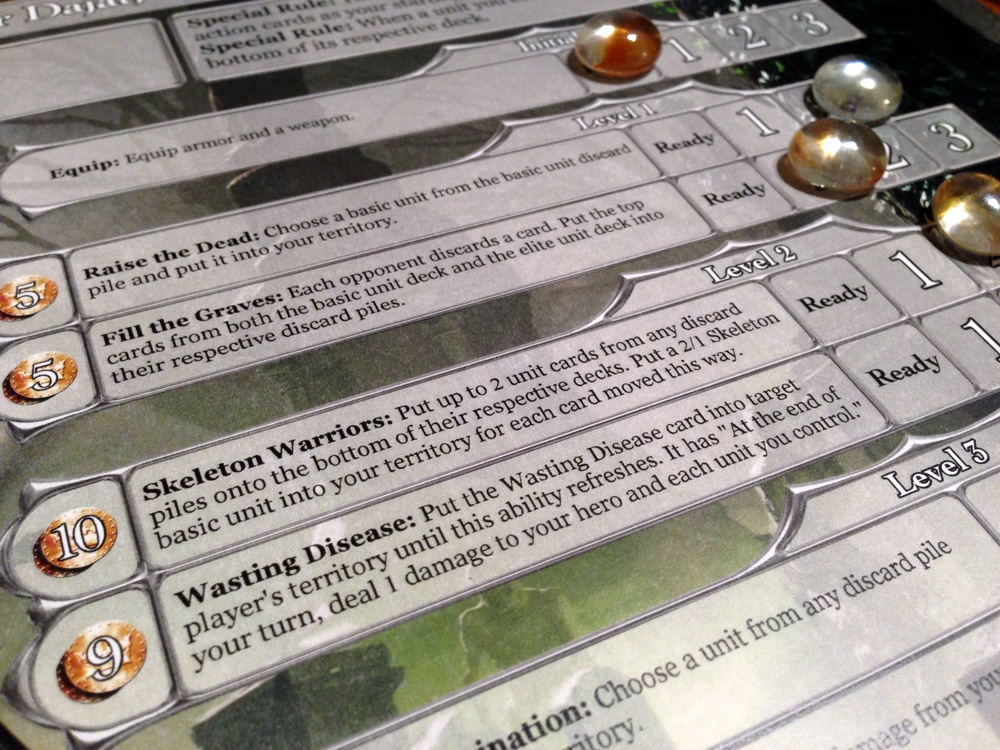
Game Experience:
I’m really looking forward to Allegiance being published. They’ve taken a tried and true concept with MtG and really turned it on its head into something that can easily stand on its own. Being able to control a unique hero in this game is really what makes it for me. Not only do the heros have different powers and weapons, but they actually feel different when you play them.
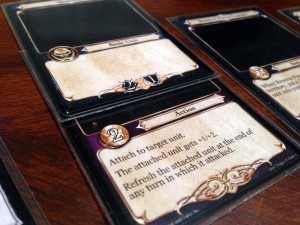
For example, the Necromancer never draws unit cards; he can only draw action cards. What he can do, however, is raise units from the dead. The Necromancer can flip through the discard pile and pick a unit to raise to the battlefield. No other player can do this. So not only does this allow the player to have a unique strategy, it also adds to the replay value of the game. I found myself wanting to try a version of the game with each of the different heroes just to see how they played. I’ve always been a big fan of asymmetrical game play and unique powers for players, so this is a home run in my book.
The decision to go with shared decks was an interesting one for Allegiance. As much as I enjoy deck construction, I think this choice was the right one. This feature allows Allegiance to avoid becoming another Collectible Card Game (CCG). I consider CCGs giant money sinks and have a self-imposed ban on buying them. As much as I enjoy opening up booster packs like a kid on Christmas, I don’t enjoy all the money you have to spend to remain competitive. Allegiance is a completely self-contained game (barring future expansion packs). So not only does that avoid me having to drop lots of money on randomized booster packs, it allows us to jump right into a game without having to work about building a deck. These are all great things in my opinion.
I know some of you might be lamenting the loss of building and optimizing your play deck. Don’t worry. Allegiance is less about optimize a play deck and is more about being adaptive to the game conditions while using your hero to the best of their ability. Make no mistake, your hero is the central part of this game and will completely change the way you play it. Players of the Commander Hero will concentrate on trying to get as many units as possible onto the battlefield while the Paladin will utilize his many healing and defensive powers to keep his units alive for as long as he can. In one of our test games, one of the players mostly ignored his hero’s powers and concentrated on playing units. That didn’t work out very well. When you get to the level 3 and level 4 hero powers they can be quite powerful.
Speaking of power, when playing Allegiance, you’ll notice that it has a neat ramp-up to its game play. There are no “mana shortages” due to bad draws to worry about. Each turn, a player gains an additional gold to spend. So by the 7th turn, you’ll be earning 12 gold on a turn. That is the territory where players will be unlocking either their 3rd tier abilities or enlisting elite units. Game play in Allegiance transitions from a steady buildup into a giant arms race. This is where you see if your early decisions will pay off. Make no mistake; there are some powerful units and abilities later in the game. The power curve really jumps and, for me, this is where the game gets really interesting. Lots of damage points will be flying around, the special abilities get more dyamnic and players will know quickly how much trouble they are in.
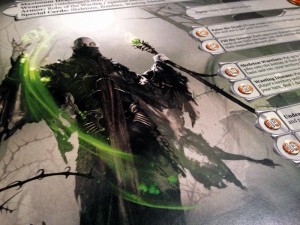
The last detial that I’d be remiss not to mention is the artwork in Allegiance. I know we don’t usually comment on artwork and components in a preview, but the direction the artwork is going in Allegiance is nothing short of stunning. We got a few sample characters illustrated in our prototype (see the photos) and I love it. I really can’t wait to see the rest of the game come to shape. I know artwork can be a huge investment for a card game, but Underground Games did a great job choosing their artist.
Final Thoughts:
Allegiance can easily stand on its own in a MtG dominated world. I think there is enough different here that lets this game really shine. Players who are looking for something a little different, but in the same vein as Magic should absolutely check out Allegiance.
For those players that want to dip their feet into the strategic card game genre, then Allegiance will make a great choice. The rules are easy to learn, the game is self-contained so you don’t have to drop a lot of money on boosters, and the nice variety of heroes will make for some great replay value. All-in-all, Allegiance: A Realm Divided appeared to be a great entry to the strategic card game genre and I look forward to checking out the final, published version.
If you are interested in the game, it’s now in funding on Kickstarter and is scheduled for delivery in February 2015. A pledge of $55 will get you a copy of the game and any stretch goals. You have until Monday, April 28 to become a backer so head over today if you are interested.
As always, we don’t post ratings for preview copies as the components and rules may change from the final game. Check back with us after the game is produced for a full review








